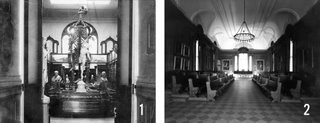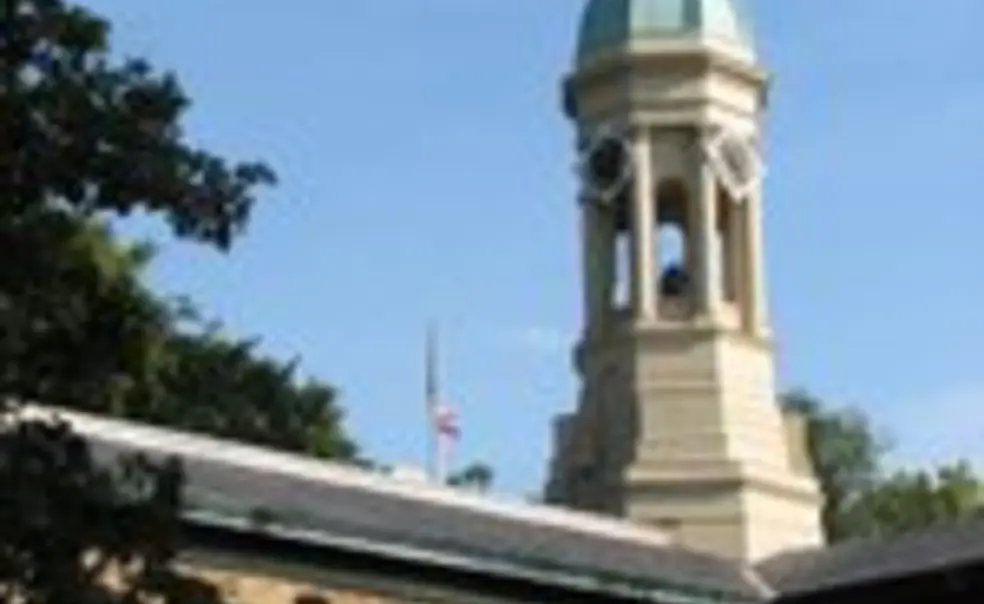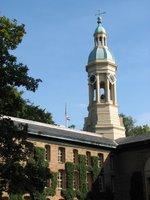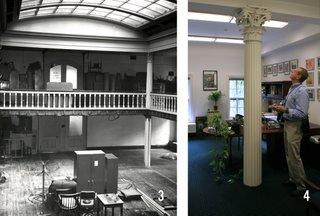The Weekly Blog: 10/18/06
NOTE: This post was originally published at princetonalumniweekly.blogspot.com/
Nassau Hall: 250 years of change
Since 1756, Nassau Hall has played a central role in the University’s history, from its early days, when it housed the entire College of New Jersey, to its current function as an administrative hub. “As the University has changed, the building itself has really changed and evolved,” said Richard Smith, curator of a new exhibit celebrating the first 250 years of Nassau Hall, on display at the Frist Campus Center Oct. 21 through Nov. 30.
 Smith, a program administrator in the ecology and evolutionary biology department and the author of Princeton University, a recent volume in Arcadia Publishing’s Campus History Series, said that the faculty room offers a perfect illustration of those changes. Today, with its long pews reminiscent of the British House of Commons, the room seems like a throwback to colonial times. But in the original Nassau Hall, the room was much smaller and served as the prayer hall. The space was expanded after a fire in 1855, converted to a library, and later refashioned to house the University museum (1), with a second-floor gallery and a skylight in the middle. The current faculty room (2) was not built until 1906.
Smith, a program administrator in the ecology and evolutionary biology department and the author of Princeton University, a recent volume in Arcadia Publishing’s Campus History Series, said that the faculty room offers a perfect illustration of those changes. Today, with its long pews reminiscent of the British House of Commons, the room seems like a throwback to colonial times. But in the original Nassau Hall, the room was much smaller and served as the prayer hall. The space was expanded after a fire in 1855, converted to a library, and later refashioned to house the University museum (1), with a second-floor gallery and a skylight in the middle. The current faculty room (2) was not built until 1906.With the new faculty room in place, the museum moved to the east wing of Nassau Hall, on the second and third floors (3). But that space eventually was converted to offices; some offices still contain the ornate columns that stood near the museum’s corners, as Smith found (4).
The exhibit will include archival photos and memorabilia, as well as materials removed from Nassau Hall: a railroad track, used in the ceiling as part of the 1855 renovation; a stolen bell clapper that was confiscated by Public Safety and still carries its “evidence” tag; and an original stone that was lifted out to make space for a class ivy marker.
The trustees chose sandstone instead of the more fashionable brick, Smith said, and the stone was quarried near what is now the intersection of Washington and Faculty roads. The 26-inch thick walls later provided temporary refuge for British troops during the Battle of Princeton and also helped Nassau Hall withstand its two terrible fires, in 1802 and 1855. Said Smith: “They built of the local stone, and it’s because of the local stone that this building is still here.”
Visit the University’s community and regional affairs Web site for a complete calendar of events celebrating the 250th anniversary of Nassau Hall.
Photos courtesy of (1) Historical Society of Princeton; (2) and (3) Princeton University Archives; (4) Denise Applewhite, Office of Communications. Top photo by Brett Tomlinson.

On the scene
Princeton midfielder Sarah Reinprecht '09 pursues the ball against Brown's Rebecca Mondics Oct. 14 in a battle for first place in the Ivy League. The Tigers won, 6-1, to remain undefeated in Ivy play.
Photo by Frank Wojciechowski
Orange and Crimson on an autumn afternoon
Echoes of the fall foliage will dot the green fields of Princeton on Saturday, Oct. 21, as the Tigers take on Harvard in four Ivy League contests, including two that could help decide league championships.
The marquee event is a football clash of undefeated teams at Princeton Stadium (noon, TV: YES Network; Radio: WBUD, AM-1260, Trenton). Princeton will try to contain Clifton Dawson, Harvard’s explosive running back, who has averaged 137 yards per game and scored a league-best 12 touchdowns. So far, Princeton’s defense has excelled, allowing less than 12 points per game, and in five weeks, three Tigers – safety Tim Strickland ’07, cornerback J.J. Artis ’07, and tackle Tom Methvin ’09 – have been honored as the Ivy League Defensive Player of the Week.
Princeton field hockey also faces the Crimson at noon, in Class of 1952 Stadium. A win for the Tigers will clinch at least a share of the Ivy title. Men’s soccer plays Harvard at 4 p.m. at Lourie-Love Field, and women’s soccer completes the day with a 7 p.m. matchup against the Crimson, also at Lourie-Love Field.
Four quarters of Princeton-Harvard football trivia
1. Following a disagreement between Princeton and Harvard in 1926, the two schools did not play against each other for seven seasons. Who replaced the Crimson on the Tigers’ 1927 schedule?
a. Ohio State
b. Penn State
c. Trenton State
2. Dick Kazmaier ’52 set a Princeton single-game record against Harvard in 1950 that still stands. What was it?
a. Most rushing yards
b. Most touchdowns
c. Most yards per play
3. In 1966, Princeton, Harvard, and Dartmouth shared the Ivy League football championship. What was the result of the Princeton-Harvard game that year?
a. Harvard won, 9-7
b. Princeton won, 18-14
c. Princeton and Harvard tied, 7-7
4. When was the last time Princeton beat Harvard at home?
a. 2004
b. 1994
c. 1990
Answers at the bottom of this post.
The sounds of water rising
Cara Reichel ’96 will direct a New York City production of The Flood, a musical about an Illinois community’s struggle against the rising tide of the Mississippi River during the summer of 1993, from Oct. 21 through Nov. 19 at the Chernuchin Theatre, 314 West 54th St. The show features music and lyrics by Reichel and Peter Mills ’95 and will be performed by Prospect Theater, a musical theatre group in New York. Visit Prospect Theater’s Web site for more information.
Football trivia answers
1. a. Ohio State – the Tigers won, 20-0; 2. c. Most yards per play – 16.6 (15 plays, 249 yards); 3. b. Princeton won, 18-14; 4. b. 1994.














No responses yet